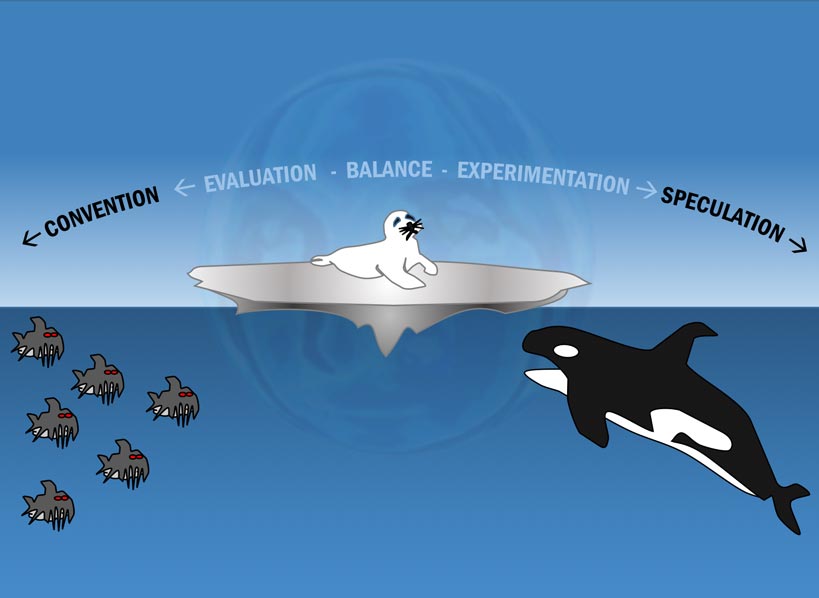Marketing in support of any complex technology is an inherently unstable proposition.
Competition relentlessly drives innovation, and that need for innovation will
drive change in how you position and sell your solution.
As your company evolves and adjusts to market pressures and
growing expectations, it is a safe bet that your marketing strategy and message
will be revisited early and often. Here’s a simple model for negotiating this
level of change.
I’m sure you’ve seen the “tip of the iceberg” metaphor used
to represent how the part you can see above the surface (i.e. your personal
appearance, or the company image), is dwarfed by the underlying chunk of ice
that carries a lot more weight (examples here).
While this metaphor is fine for many purposes, I’d like to
propose a reverse iceberg platform for technology marketing that is
inherently unstable. In an environment where you are often only as good as your
last release, marketing loses much of the inertia underpinning the business
itself. Even well-established brands are subject to being “flipped” out of the
market – half of the S&P 500 Index companies are likely to be replaced in the next 10 years, if estimates hold up.

Basic Reverse Iceberg of technology marketing concept.
Let’s say your marketing message is a cute seal, riding on a fresh chunk of ice, broken off of the permanent shelf it once frolicked upon. If you are that seal, you should not lean your ice sheet too far forward (speculation), nor attempt to inhibit change by leaning too far back (convention).
To survive on this platform, your message must not only be differentiated and fit your brand, it must continuously avoid the two extremes of speculation and convention as it moves forward on the current, to avoid being toppled.
I liked comparing the surface to ice, rather than a surfboard
or boat, because it takes into account the “slippery slope” effect of not being
able to reverse course if you get too far out of balance.
How do these extreme forces play out in messaging your technology?
Speculation. This
is commonly referred to as “getting ahead of yourself” or “being out over your
skis,” and chances are you’ve already seen enough high-profile examples of this
in action. It is natural to want to aggressively go to market in response to perceived
threats or opportunities, but leaning too far forward can accelerate a problem
for a company that cannot meet demand.
For instance, let’s say you are running a massive ad
campaign to announce a product launch, without the necessary support on your
site or service to handle the increase in traffic. Or, your sales teams are
delivering a message – invented in PowerPoint – around product features that
are not yet delivered or proven by customers.
- Problems:
High inconsistency of message, high risk of failure, poor customer experience,
loss of credibility, inability to capitalize on interest or demand, fast
customer churn
- Solutions:
Try evolutionary vs. revolutionary changes, soft launch or graduated release, be
more selective about target customers, run advance beta or survey programs, recruit
customer or expert validation, track customer value as a success metric, go
deeper
Convention. The
risk in this conservative approach to messaging is often much harder to detect
until it is too late, as it happens over a period of time. Even very large companies
can scarcely afford to stand still, as dominant players can suffer the “death of
a thousand bites” of nimbler companies that are not only doing specific work
better, but targeting messages to specific customer needs more accurately.
Overly conventional marketing focuses on message parity –
what industry peers, analysts and competitors are already talking about, rather
than expressing a unique point of view and direction. While it is
counterproductive to attempt to forge a totally unique message every time, your
message does need to demonstrate that you are evolving, thinking, and actively
participating in the exchange that drives your market.
Don’t be jealous about allowing your experts to evangelize innovative
ideas, either – if the topics are worth discussing, they are not as proprietary
or as permanent as you may think. Remember that if you don’t express market-leading
ideas, chances are someone else will.
- Problems: Becoming
irrelevant to the market, slow content production, undifferentiated or boring
messaging, teams and customers do not resonate with the message, competition appears
to be more advanced
- Solutions: Commit
to a thought leadership perspective, encourage customers and peers to join the
conversation, participate in communities, focus on openness, avoid jealousy, go
higher
You might say all of the above should be common sense advice,
but it is surprisingly easy for companies to fall prey to the extreme forces of
speculation and convention, given the competitive nature and high rate of
change inherent in marketing technology. Fortunately,
these extreme forces have gentler counterparts you can use to keep your
messaging in equilibrium: experimentation and evaluation.
We will take a look at these balancing forces in a future installment on the
reverse iceberg messaging topic.